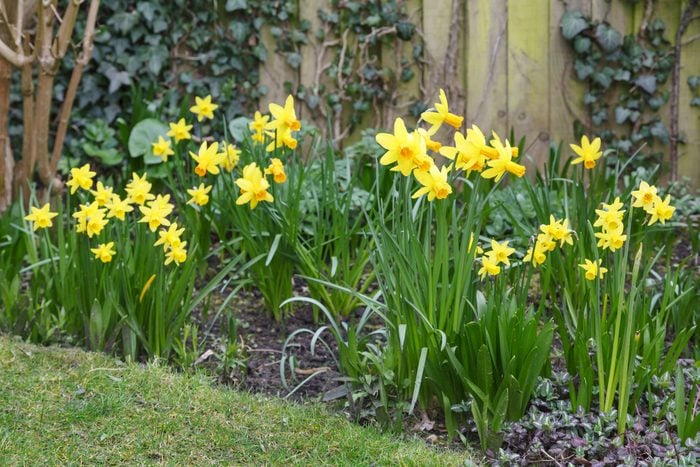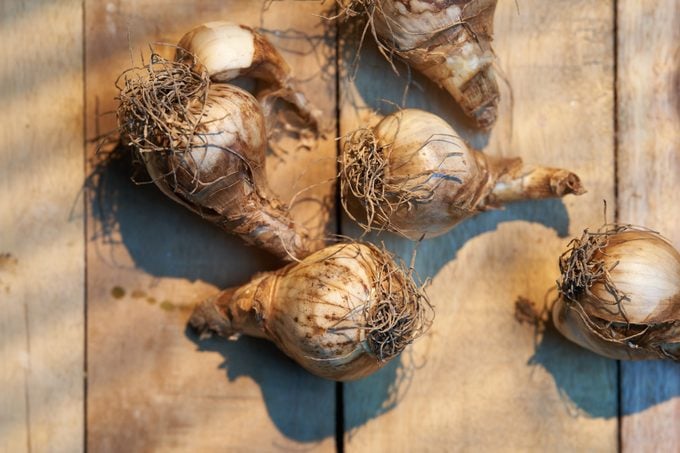Tips for Planting Daffodil Bulbs
Updated: Apr. 18, 2024

Learn all about the proper timing for buying and planting daffodils, how to plant them so you'll always see blooms, and a smart tip on harvesting.
Brent Heath knows daffodils. As a third-generation bulb seller and daffodil hybridizer for his business, Brent & Becky’s Bulbs, he will happily regale you with fascinating stories about daffodils that have been passed down through the generations.
One of my favorites is the tale of how daffodils first came to the United States. Heath describes how our nation’s first imported daffodils came from women making the ocean voyage to the U.S. from Spain, Portugal, France and Italy.
“Daffodils, being dormant in the summertime, could ride on a ship for months without any harm,” says Heath. “The ladies were given limited space to bring things from home, so they sewed daffodil bulbs into the hems of their skirts. They served two purposes: bringing something dear to them from home and weighing their skirts down when the breezes blew on the deck of the ship.”
Today, there are about 28,000 registered varieties of daffodils in the U.S., 50 of which were hybridized by Heath. Although they all bloom in shades of yellow or white, their bloom times can range widely from late fall to early summer. Most tend to flower in early spring through late spring. Popular varieties include Dutch Master, Mount Hood, Tahiti, Jetfire, Thalia and Minnow.
On This Page
When To Purchase Daffodils
You’ll find mass-produced varieties of daffodils for sale at your local garden centers and home improvement stores beginning in early fall. But, for something more unique, try a mail order source, like Brent & Becky’s Bulbs, John Scheepers and Old House Gardens Heirloom Bulbs. The earlier you order, the better the selection.
Note: Be sure to check the USDA zone on the variety you buy, because it can vary greatly— from USDA zones 3 through 9.
When To Plant Daffodils
It’s usually a little too early to plant daffodils when they first start appearing in stores. Wait until the soil temperature ranges from 50 F to 60 F (usually around six weeks before the ground freezes) because that is when spring flowering bulbs make their roots. A thick layer of mulch will help keep the ground warmer for longer, so they have more time to get established.
It is vitally important that newly planted daffodil bulbs start to produce roots before the ground freezes. Once they do so, the cell walls of the bulbs become elastic. Heath describes it as if the bulbs become infused with “antifreeze.” Without it, they can freeze and then rot.
Where To Plant Daffodils
Choosing a suitable place to plant daffodils is one of the most important factors in their success. Look for a spot that receives sun for at least eight hours per day and is relatively dry with excellent soil drainage. If you plant them in shady, moist conditions, you’re not likely to see them bloom and the bulbs may succumb to a fungal disease called Fusarium oxysporum.
Don’t be fooled by how sunny your garden is in early spring before the trees leaf out. Daffodils need at least eight more weeks of sunshine after they finish blooming to soak up enough energy to be able to bloom again the following spring. Consequently, plant daffodil bulbs away from the shade cast by tall tree canopies. It’s alright if your hose can’t reach there.
“Like people, most bulbs prefer to sleep in a dry bed when they are dormant,” says Heath.
Because a daffodil’s leaves need to be exposed to the sun to make energy for the plant, they should never be bunched together or bundled after they are finished blooming. That practice not only prevents the plant from making energy, it can also trap water around the top of the bulb and promote disease.
Instead, disguise your daffodils’ foliage as it is going dormant by planting taller plants around the bulbs or redirecting the eye with brightly colored flowers blooming in the opposite corner of the garden. Once a daffodil’s leaves have turned yellow, you can safely remove them without harming the now-dormant bulbs.

How To Plant Daffodils
If you have an auger handy, it is an excellent tool to use for planting daffodils because they like to be planted deep. Good quality daffodil bulbs are typically about two inches tall and weigh about as much as a golf ball. The planting hole should be three times the height of the bulb, so you’ll need to drill or dig about a six-inch-deep hole for each bulb. An auger makes quick work of it.
Be sure to set the bulb in the bottom of the hole with the pointy side facing up. The stem and leaves will emerge from the top and the roots will grow from the flattish bottom of the bulb.
Like most plants, daffodil bulbs thrive when essential nutrients are present. They respond with great vigor when fed with compost. Mix a bit of compost in with your native soil when you backfill the hole, then topdress the bulbs with another 1-inch deep layer of compost in spring.
Natural Repellent
One big reason people choose to grow daffodils instead of tulips is that they are virtually pest-proof. That’s because they are poisonous. The botanical name for daffodil is Narcissus, which is derived from the root word narcos which means “narcotic.” The alkaloid in a daffodil (which is what makes it poisonous) is a deadly narcotic.
The good news, as Heath explains, is that “They taste so bad that you really don’t have to worry about pets or children eating them.” Even insects find daffodil pollen to be distasteful. The plants rarely set seeds because their flowers are not pollinated.
Enjoy Your Daffodils Every Spring
Once you’ve planted your daffodil bulbs in the fall, there is little left to do but wait to enjoy the flowers that will sprout the following spring. All the energy they need to bloom is already contained within the bulb, so no chemical fertilizers are needed to make them produce flowers. The compost you added in the fall will be sufficient.
Daffodils are perennial bulbs that return and bloom year after year without needing to be replanted. If grown in the proper environment, a single clump of daffodils can live 100 years or more. Each bulb will multiply, and the clump will expand each season.
If you’d like to divide your daffodil bulbs to spread around to other places in your garden, do so just as the leaves are beginning to turn yellow in summer. Lift the whole clump, pull apart the bulbs, and replant them in their new home using the method described above. Here are a few tips for replanting potted plants.
“To pick a daffodil, run your finger down the stem, put your thumb on the opposite side, and pull up to snap the stem,” says Heath. “Don’t cut the stem to pick it. Pulling the stem off the bulb will result in a stem that holds water better and flowers that last longer in a vase.”
